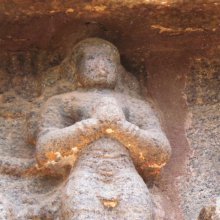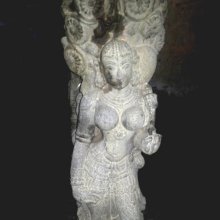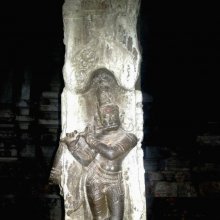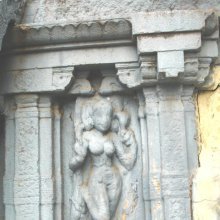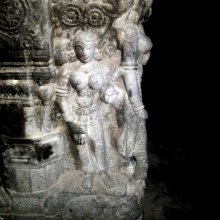Stambhana: 24 definitions
Introduction:
Stambhana means something in Buddhism, Pali, Hinduism, Sanskrit, Marathi, Hindi. If you want to know the exact meaning, history, etymology or English translation of this term then check out the descriptions on this page. Add your comment or reference to a book if you want to contribute to this summary article.
Alternative spellings of this word include Stambhan.
Images (photo gallery)
(+55 more images available)
In Hinduism
Ayurveda (science of life)
Toxicology (Study and Treatment of poison)
Source: Shodhganga: Kasyapa Samhita—Text on Visha Chikitsa1) Stambhana (स्तम्भन) refers to “shock”, and is a symptom caused by snake-bites (such as the Śophamaṇḍalī-snakes), according to the Kāśyapa Saṃhitā: an ancient Sanskrit text from the Pāñcarātra tradition dealing with both Tantra and Viṣacikitsā—an important topic from Āyurveda which deals with the study of Toxicology (Viṣavidyā or Sarpavidyā).—[Cf. aśaktiḥ stambhanaṃ jāḍyaṃ pāvaraśyam arocakam]
2) Stambhana (स्तम्भन) refers to “obstructed (urination)” caused by snake-bites, according to the Kāśyapa Saṃhitā.—The Kāśyapasaṃhitā verse IX.66-7 prescribe an effective generic cure for constipation and obstructed (stambhana) urination [viṃstambhane nābher adholepyaṃ viṣasya viṭ], caused by snake bite—water with rice mixed with the bile of frog must be applied under the navel. The powdered root of Piṇḍālapatrika mixed with cold water must be smeared on the stomach. These two procedures effectively address both the problems, resulting in immediate urination and expulsion of feaces from the system.
Unclassified Ayurveda definitions
Source: Wisdom Library: Āyurveda and botanyStambhana (स्तम्भन, “retaining”).—One of the six Upakramas, or ‘therapeutic measures’.—It is a Sanskrit technical term used through Ayurvedic (Indian medicine) literature such as the Carakasaṃhitā. The six Upakramas represent basic Ayurvedic therapies. The Stambhana treatment refers to a “blocking/ stopping treatment” or “astringent therapy” and aims to ‘contract/retain’ the flow of bodily fluids, including sweat, urine, blood and faeces.
Source: gurumukhi.ru: Ayurveda glossary of termsStambhana (स्तम्भन):—[stambhanaṃ] Substances used to check any flow through or out of the body
Source: National Mission for Manuscripts: Traditional Medicine System in IndiaStambhana (स्तम्भन) refers to “cooling” and is the action (karma) associated with Hima or Śīta (“cool”): one of the twenty Śārīraguṇa (or Gurvādiguṇa), which refers to the “twenty qualities of the body”—where guṇa (property) represents one of the six divisions of dravya (drugs).—Śārīraka-guṇas are twenty in number. There are ten guṇas with their opposite guṇas. [...] Hima (“cold”) has the predominant bhūta (element) of water and the associated actions of “cooling/stambhana”; while Uṣṇa (“hot”) has the predominant bhūta (element) of agni and is associated with the action “healing/svedana”.

Āyurveda (आयुर्वेद, ayurveda) is a branch of Indian science dealing with medicine, herbalism, taxology, anatomy, surgery, alchemy and related topics. Traditional practice of Āyurveda in ancient India dates back to at least the first millenium BC. Literature is commonly written in Sanskrit using various poetic metres.
Natyashastra (theatrics and dramaturgy)
Source: Wisdom Library: Nāṭya-śāstraStambhana (स्तम्भन, “motionlessness”) refers to a specific gesture (āṅgika) made with the thighs (ūru), according to the Nāṭyaśāstra chapter 10. These gestures form a part of the histrionic representation (abhinaya).
Source: archive.org: Natya ShastraStambhana (स्तम्भन, “motionlessness”).—A type of gesture (āṅgika) made with the thighs (ūru);—Instructions: suspension of movement. Uses: in perturbation and despair.

Natyashastra (नाट्यशास्त्र, nāṭyaśāstra) refers to both the ancient Indian tradition (shastra) of performing arts, (natya—theatrics, drama, dance, music), as well as the name of a Sanskrit work dealing with these subjects. It also teaches the rules for composing Dramatic plays (nataka), construction and performance of Theater, and Poetic works (kavya).
Shaivism (Shaiva philosophy)
Source: Shodhganga: Mantra-sādhana: Chapter One of the KakṣapuṭatantraStambhana (स्तम्भन) refers to “immobilizing others” and represents a ritual according to the Kakṣapuṭatantra verse 70-71: “one should fix the mind firmly, focusing on the four-petalled lotus of the secret place at the bottom. One will accomplish the rasa-siddhi, likewise, vaśya, ākṛṣṭi, kālavacana (cheating death), kāryārambhana (operation) of poison, bhūta, and so on, gamāgama (going to and fro), sārasvata (acquiring eloquence), and stambhana, through japa, using the leftward flow [of prāṇa (breath)]”.

Shaiva (शैव, śaiva) or Shaivism (śaivism) represents a tradition of Hinduism worshiping Shiva as the supreme being. Closely related to Shaktism, Shaiva literature includes a range of scriptures, including Tantras, while the root of this tradition may be traced back to the ancient Vedas.
Shaktism (Shakta philosophy)
Source: Google Books: ManthanabhairavatantramStambhana (स्तम्भन) refers to one of the eight Heroes (vīra-aṣṭaka) associated with Jālandhara (which is in the southern quarter), according to the Manthānabhairavatantra, a vast sprawling work that belongs to a corpus of Tantric texts concerned with the worship of the goddess Kubjikā.—[...] The eight heroes: Ananta, Jvāla, Jṛmbhaṇa, Stambhana, Mohana, Stambhakārī, Saṃkarṣaṇa, Vighnāntaka.
Source: Google books: Genesis and Development of Tantra (Shaktism)Stambhana (स्तम्भन, “paralysing”) refers to one of the twelve kinds of black magic (abhicāra) which represents one of the various Siddhis (“supernatural powers”) according to the Siddhayogeśvarīmata: an ancient Sanskrit text devoted to cults of Goddesses as the Vidyāpīṭha or Vidyā Corpus.—Although Vedic rituals were a reliable way for the people of ancient India to fulfill their objectives, Tantric rites too claim to bring about the attainment of wishes. [...] In the Siddhayogeśvarīmata, the objectives of the rites are classified as siddhis [e.g., twelve kinds of black magic (abhicāras) such as paralysing (stambhana)]. They belong to the category of supernatural phenomena and seem to be considerably different from the types of wish people expected to gain from the Vedic rituals that still remained within the sphere of everyday life.

Shakta (शाक्त, śākta) or Shaktism (śāktism) represents a tradition of Hinduism where the Goddess (Devi) is revered and worshipped. Shakta literature includes a range of scriptures, including various Agamas and Tantras, although its roots may be traced back to the Vedas.
Mantrashastra (the science of Mantras)
Source: Shodhganga: Kasyapa Samhita—Text on Visha Chikitsa (mantra)Stambhana (स्तम्भन) refers to “deadening of faculties” and represents one of the eight divisions of the object or purpose of a Mantra, according to the Śrīpraśṇa-saṃhitā (verse 50.70-2).—Mantras refers to “that which is chanted by people to obtain their spiritual aspirations”.
Mantrashastra (शिल्पशास्त्र, mantraśāstra) refers to the ancient Indian science of mantras—chants, incantations, spells, magical hymns, etc. Mantra Sastra literature includes many ancient books dealing with the methods reciting mantras, identifying and purifying its defects and the science behind uttering or chanting syllables.
Purana and Itihasa (epic history)
Source: archive.org: Shiva Purana - English TranslationStaṃbhana (स्तंभन) refers to “paralyzing” or “benumbing (someone’s hand)”, according to the Śivapurāṇa 2.5.13 (“Resuscitation of Indra”).—Accordingly, as Sanatkumāra narrated to Vyāsa: “After saying this and looking at him ferociously Indra raised his thunderbolt in order to kill him. On seeing Indra lifting up his thunderbolt, Śiva prevented the fall of the thunderbolt by making his hand benumbed (staṃbhana). Then Śiva became furious. His eyes became terrible. He blazed with his burning splendour. [...]”.

The Purana (पुराण, purāṇas) refers to Sanskrit literature preserving ancient India’s vast cultural history, including historical legends, religious ceremonies, various arts and sciences. The eighteen mahapuranas total over 400,000 shlokas (metrical couplets) and date to at least several centuries BCE.
In Buddhism
Tibetan Buddhism (Vajrayana or tantric Buddhism)
Source: academia.edu: The Structure and Meanings of the Heruka MaṇḍalaStambhana (स्तम्भन) refers to one of the eight charnel grounds (śmaśāna) of the Medinīcakra, according to the 10th century Ḍākārṇava chapter 15. Accordingly, the medinīcakra refers to one of the three divisions of the dharma-puṭa (‘dharma layer’), situated in the Herukamaṇḍala. Stambhana is associated with the tree (vṛkṣa) named Rudra; with the female world-guardian (lokapālinī) named Vāyubhāryā; with a female serpent (nāginī) and with a female cloud (meghinī).

Tibetan Buddhism includes schools such as Nyingma, Kadampa, Kagyu and Gelug. Their primary canon of literature is divided in two broad categories: The Kangyur, which consists of Buddha’s words, and the Tengyur, which includes commentaries from various sources. Esotericism and tantra techniques (vajrayāna) are collected indepently.
Languages of India and abroad
Marathi-English dictionary
Source: DDSA: The Molesworth Marathi and English Dictionarystambhana (स्तंभन).—n (S) Stopping, arresting and bringing to a stand: also obstructing, preventing progress or motion. 2 (See saptōpacāra) Suppressing (as of any of the functions or faculties of an animal by ma- gical incantations, or by medicines or any measures): also fixing of any of the limbs or members. 3 Anything (a charm, a medicine &c.) by which suppression or stoppage (of a function &c.) is accomplished. 4 Restraining the semen (through medicine or mantra): also the medicine &c. effecting this restraint.
Source: DDSA: The Aryabhusan school dictionary, Marathi-Englishstambhana (स्तंभन).—n Stopping; suppressing.
Marathi is an Indo-European language having over 70 million native speakers people in (predominantly) Maharashtra India. Marathi, like many other Indo-Aryan languages, evolved from early forms of Prakrit, which itself is a subset of Sanskrit, one of the most ancient languages of the world.
Sanskrit dictionary
Source: DDSA: The practical Sanskrit-English dictionaryStambhana (स्तम्भन).—[stambhayati stambh-ṇic lyuṭ]
1) Stopping, obstructing, hindering, arresting, suppressing, restraining; लोलोल्लोलक्षुभितकरणोज्जृम्भणस्तम्भनार्थम् (lolollolakṣubhitakaraṇojjṛmbhaṇastambhanārtham) Uttararāmacarita 3.36.
2) Paralysing, benumbing, stupefying.
3) Quieting, composure; पराङ्मुखेऽपि दैवेऽत्र कृत्यं कार्यं विपश्चिता । आत्मदोष- विनाशाय खचित्तस्तम्भनाय च (parāṅmukhe'pi daive'tra kṛtyaṃ kāryaṃ vipaścitā | ātmadoṣa- vināśāya khacittastambhanāya ca) || Pañcatantra (Bombay) 1.36.
4) Making firm or stiff, fixing firmly.
5) Propping, supporting.
6) Stopping the flow of blood.
7) Anything employed as an astringent.
8) A particular magical art or faculty; see स्तम्भ (stambha) (1).
-naḥ Name of one of the five arrows of Cupid.
Derivable forms: stambhanam (स्तम्भनम्).
Source: Cologne Digital Sanskrit Dictionaries: Shabda-Sagara Sanskrit-English DictionaryStambhana (स्तम्भन).—n.
(-naṃ) 1. Stopping, hindering, obstruction. 2. Suppression of any of the bodily faculties by magical incantations. 3. Stopping the flow of blood, &c. 4. Any article so employed, a styptic, an astringent. 5. Stunning, benumbing. 6. Propping, supporting. m.
(-naḥ) An epithet of one of the five arrows of Kamadeva. E. ṣṭabhi to stop, aff. yuc or lyuṭ .
Source: Cologne Digital Sanskrit Dictionaries: Benfey Sanskrit-English DictionaryStambhana (स्तम्भन).—[stambh + ana], I. m. One of Kāma’s arrows. Ii. n. 1. Supporting, holding upright, [Pañcatantra] i. [distich] 405. 2. Stopping. 3. Suppressing the use of the faculties by magic.
Source: Cologne Digital Sanskrit Dictionaries: Cappeller Sanskrit-English DictionaryStambhana (स्तम्भन).—([feminine] ī) & [neuter] laming, paralyzing, fixing, stopping, restraining.
Source: Cologne Digital Sanskrit Dictionaries: Monier-Williams Sanskrit-English Dictionary1) Stambhana (स्तम्भन):—[from stabh] mf(ī)n. stiffening, making rigid or immovable, paralyzing, [Kāvya literature; Hemacandra’s Pariśiṣṭaparvan]
2) [v.s. ...] stopping, arresting, checking, restraining, [Mahābhārata; Rāmāyaṇa]
3) [v.s. ...] styptic, astringent, [Suśruta]
4) [v.s. ...] m. ‘paralyzer’, Name of one of the five arrows of Kāma-deva, [Catalogue(s)]
5) [from stabh] n. the act of turning into a pillar (See rambhā-st)
6) [v.s. ...] strengthening, supporting, [Kāvya literature; Pañcarātra]
7) [v.s. ...] becoming stiff or rigid, [Suśruta]
8) [v.s. ...] making stiff or rigid, paralysing, [Vāsavadattā; Bālarāmāyaṇa]
9) [v.s. ...] a means of making stiff or rigid, [Hemādri’s Caturvarga-cintāmaṇi]
10) [v.s. ...] stopping, arresting (also by magical means), [Mahābhārata; Viṣṇu-purāṇa]
11) [v.s. ...] stopping flow of blood etc.
12) [v.s. ...] a styptic or astringent, [Caraka]
13) [v.s. ...] a [particular] magical art or faculty (See under stambha and cf. jala-stambhana).
Source: Cologne Digital Sanskrit Dictionaries: Yates Sanskrit-English DictionaryStambhana (स्तम्भन):—(naḥ) 1. m. One of the arrows of Kāmadeva. n. Stopping, hindering; suppressing the use of the faculties by magic.
Source: DDSA: Paia-sadda-mahannavo; a comprehensive Prakrit Hindi dictionary (S)Stambhana (स्तम्भन) in the Sanskrit language is related to the Prakrit words: Thaṃbhaṇa, Thaṃbhaṇayā.
[Sanskrit to German]
Sanskrit, also spelled संस्कृतम् (saṃskṛtam), is an ancient language of India commonly seen as the grandmother of the Indo-European language family (even English!). Closely allied with Prakrit and Pali, Sanskrit is more exhaustive in both grammar and terms and has the most extensive collection of literature in the world, greatly surpassing its sister-languages Greek and Latin.
Hindi dictionary
Source: DDSA: A practical Hindi-English dictionaryStaṃbhana (स्तंभन) [Also spelled stambhan]:—(nm) retention; astringency; restraining, stopping, arresting.
...
Kannada-English dictionary
Source: Alar: Kannada-English corpusStaṃbhana (ಸ್ತಂಭನ):—
1) [noun] a stopping, arresting or checking.
2) [noun] the act of weakening or inactivating (another).
3) [noun] the act of calming, tranquilising or soothing; tranquilisation; pacification.
4) [noun] a stiffening, making rigid or immovable.
5) [noun] the act or an instance of providing (something) with a rigid support.
6) [noun] name of one of the five arrows of Manmatha, the God of Love.
7) [noun] magic with an evil pupose; sorcery.
8) [noun] (rhet.) the condition or feeling of swooning; fainting.
Kannada is a Dravidian language (as opposed to the Indo-European language family) mainly spoken in the southwestern region of India.
See also (Relevant definitions)
Starts with: Stambhanadattatreya, Stambhanadividhi, Stambhanagai, Stambhanaka, Stambhanakavatara, Stambhanakshara, Stambhanaprakara, Stambhanarasimha.
Ends with: Agnistambhana, Ativishtambhana, Avashtambhana, Divastambhana, Garbhastambhana, Hridayastambhana, Jalastambhana, Jambharibhujastambhana, Mutrastambhana, Paryavashtambhana, Rambhastambhana, Rangastambhana, Salilastambhana, Samstambhana, Shukrastambhana, Upastambhana, Viryastambhana, Vishtambhana, Vitstambhana.
Full-text (+36): Thambhana, Satkarman, Thambhanaya, Stambhanaprakara, Upastambha, Stambhan, Stabhu, Stambhani, Jalastambhana, Stambhane, Vayustampanam, Agnistambhana, Stambhanadividhi, Divastambhana, Asurividya, Stambhitarambha, Thamana, Upastambhana, Jambharibhujastambhana, Rambhastambhana.
Relevant text
Search found 12 books and stories containing Stambhana, Staṃbhana, Stambhanā, Staṃbhanā; (plurals include: Stambhanas, Staṃbhanas, Stambhanās, Staṃbhanās). You can also click to the full overview containing English textual excerpts. Below are direct links for the most relevant articles:
Garga Samhita (English) (by Danavir Goswami)
Verse 4.11.16 < [Chapter 11 - The Story of the Gopīs that were Residents of...]
Verse 4.19.134 < [Chapter 19 - A Thousand Names of Srī Yamunā]
Chaitanya Bhagavata (by Bhumipati Dāsa)
Verse 2.23.273 < [Chapter 23 - Wandering about Navadvīpa On the Day the Lord Delivered the Kazi]
Varahi Tantra (English Study) (by Roberta Pamio)
Chapter 23 - Prayoga (the application of the Sādhanā of a deity) < [Summary of the Vārāhī Tantra]
Natyashastra (English) (by Bharata-muni)
Dvisahasri of Tembesvami (Summary and Study) (by Upadhyay Mihirkumar Sudhirbhai)
Works of Dattātreya < [Introduction]
The Agni Purana (by N. Gangadharan)

